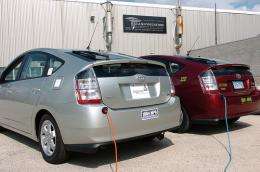Pulling the plug on hybrid myths

(PhysOrg.com) -- Whether you call them myths, urban legends, fables or old wives' tales, there's a lot of misinformation out there about plug-in electric hybrid vehicles. These vehicles, abbreviated PHEVs, hold great promise as the key to weaning America from its dependence on imported oil, which represents nearly two-thirds of all the petroleum burned in the United States today.
The U.S. Department of Energy's Argonne National Laboratory has taken a lead role in developing and testing plug-in hybrid technologies. At the lab's Center for Transportation Research (CTR), vehicle systems engineer Forrest Jehlik and his colleagues work to bring these cars to market quickly and cheaply. Here, he dispels some commonly held myths about plug-in hybrids.
Myth #1: A significant number of plug-in hybrids are currently for sale.
Although several major auto manufacturers — including General Motors, Toyota, Ford, Volkswagen, and Volvo — have plug-in vehicles currently in the development pipeline, the first wave of these cars is still at least a year away from officially hitting the market, Jehlik said. The first plug-in hybrid for sale will likely be the Chevrolet Volt, which General Motors claims can travel up to 40 miles on a single charge. The Toyota Prius and other hybrids currently on the roads are not plug-ins — their batteries are charged by kinetic energy transferred from the brakes and wheels.
Myth #2: Researchers can measure the fuel economy for a plug-in hybrid just as easily as they can for gasoline-powered cars.
Establishing fuel economy standards — how many miles a plug-in hybrid vehicle can travel per gallon of gasoline burned — is a complicated question. The answer, Jehlik said, depends entirely on the driving and charging habits of the vehicle's owner. If a particular plug-in hybrid gets 40 miles on a single charge, then a driver who has a 15-mile commute each way to work and does 10 miles of additional driving each day before charging the battery overnight would, theoretically, use no gasoline at all. If the same driver had a five-mile-longer commute, she'd probably burn just over a gallon of gasoline per week, despite driving 250 miles.
Myth #3: Prices for plug-in hybrid vehicles are currently so high because manufacturers are trying to make a killing on them.
"The truth of the matter is that the components required to build a viable plug-in hybrid are still quite expensive," Jehlik said. In many cases, the battery for a plug-in vehicle by itself costs nearly $10,000. Because the price of petroleum remains relatively low, consumers may not yet be willing to invest the extra money in a plug-in vehicle — even with sizable government rebates.
Myth #4: The batteries in plug-in hybrid vehicles are unreliable, possibly unsafe, and require frequent replacement.
Most plug-in hybrids currently under development use lithium-ion batteries in their battery packs. Although complex chemical processes produce energy within the battery, vehicle system engineers have built in advanced control systems to prevent fires or other safety issues. "Researchers have devoted just as much time and effort to developing inner-pack safety systems as they have to the batteries themselves," Jehlik said. "Consumers don't need to worry about battery malfunction."
Jehlik and his colleagues in the CTR have also tested the current generation of lithium-ion batteries in what are known as "lifecycle vehicle tests," which take the car through its paces for more than 150,000 miles. Even at the end of the car's life, the vast majority of batteries still function quite well, Jehlik said. "When these cars become available for sale, the batteries are going to last as long as any part of them will," he said.
Myth #5: Scientists have identified lithium-ion batteries as the only battery technology that could work in plug-in hybrid cars.
Although lithium-ion technology came to replace nickel-metal hydride (NiMH) batteries as the preeminent focus of electric vehicle development efforts, scientists at Argonne and around the world are currently investigating several different approaches for energy storage that could help to bring down the cost of plug-in hybrids. "Manufacturers are looking at these possible solutions not as silver bullets but as silver shotgun pellets," Jehlik said. "The organizations that hedge their bets among a number of different technologies will likely be the ones that bring vehicles to market the earliest and the most successfully."
Myth #6: America's electric grid can't handle the increased load caused by the charging of millions of electric vehicles.
According to Jehlik, the nation's current electric grid has the capacity to accommodate the imminent rollout of plug-in hybrids onto the country's roads. "If everyone were somehow able to buy a plug-in hybrid tomorrow, that would probably present a problem as far as the supply of electricity is concerned," Jehlik said, "but given the pace that they are likely to enter the market, we won't face a system-wide failure."
However, Jehlik noted that the country's electric infrastructure would need to change eventually—not only to keep up with added demand, but to ensure the smarter transmission, distribution and consumption of electricity.
Provided by Argonne National Laboratory (news : web)



















